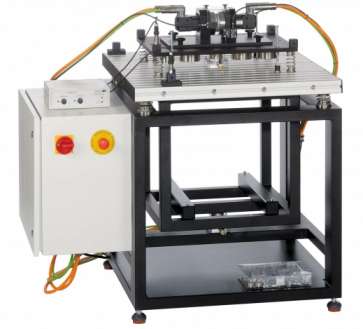EM-301.02 | Vibrations on Machine Foundation
- Length: 1140 mm
- Width: 800 mm
- Height: 1170 mm
- Weight: 311 kg
Description
Technical Specification
Media
An indispensable part of machine design is the reduction of vibrations. For example, an elastic, vibration-isolating setup of the machine avoids disruptive vibrations being transferred to the surroundings.
The TM 182 unit can be used to study the issue of machine foundations and isolation from vibrations using a practical example. To do this, vibrations are deliberately produced on an elastically mounted machine. The transfer of these vibrations to the foundation is measured. It is then possible to test different adjustments using different springs and to study absorbing effects using vibration absorbers.
The experimental setup consists of a machine, a foundation and a frame. A vibration generator serves as the machine, consisting of two independently driven imbalance sets. The imbalance sets are driven by servomotors so that any excitation forces and force directions can be generated. Alternatively, a piston compressor can be used to generate vibrations.
The machine is mounted on a foundation by means of springs and dampers. The surroundings are represented by the foundation, on which the effectiveness of the vibration isolation is measured.
The foundation is connected to the actual frame of the trainer via additional coil springs. This dual vibration isolation, together with the large weight of the foundation itself, guarantees a vibration-free operation in the laboratory even under unfavorable experimental conditions. A switch cabinet is attached to the frame, housing the control system, power supply and data acquisition.
Acceleration sensors are used to measure deflection, velocity and acceleration of the vibrations at different points. Using these measured values, it is possible to calculate and display the operational vibration modes.
Experimental Capabilities
- Familiarization with vibration phenomena on machine foundations.
- Adjust the foundation for different excitation forces.
- Investigate vibration absorbers.
- Investigate the effect of additional damping.
- Compare metal springs and rubber springs.
- Measure and analyze vibrations.
- Determine operational vibration modes.
Scope of Delivery
- 1 trainer.
- 1 vibration generator.
- 1 set of instructional material.
- Display and study vibrations on machine foundations.
- Vibration generator excites vibrations by imbalance.
- Vibration-free laboratory operation thanks to additional vibration isolation of the foundation.
- 2 brushless high-performance servomotors to drive the vibration generator.
- Eccentricity, rotational frequency, direction of rotation, adjustable phase position and frequency ratio.
- Variable arrangement of vibration absorbers.
- Vibration measurement via acceleration sensors.
- Inductive displacement sensor records the eccentricity of the imbalance masses.
- Drive motors
- Speed: 6000min-1
- Torque: approx. 3.40Nm.
- “Machine” mounted on a plate.
- Mass: max. 26kg (incl. extra weights 4x 2kg)
- Imbalance: 2x 500cmg.
- Imbalance force: 2x 500N. (up to 3000min-1)
- Foundation
- Mass: max. 73kg (incl. extra weights 5x 9,4kg)
- natural frequency: 2,66Hz
- Compression springs
- Spring stiffness C: 2,44N/mm…139,53N/mm
- Transverse stiffness Cq: 0.30N/mm…90,0N/mm
- Measuring ranges
- Acceleration: 490m/s2
Any questions? We are happy to help...
+49 40 670 854 - 0
sales@gunt.de
Newsletter
About Us
EduTech Lahore excels in designing and supplying cutting-edge equipment for Engineering Education in Mechanical,Polymer
Chemical, Civil and Control Engineering. Focused on meeting the demand for quality education, we offer cost-effective solutions for the latest teaching equipment.
Contact Info
Head Office (Asia)
EduTech
Lahore
- EduTech Lahore, 2nd Floor, Plaza No.1009, Block-F, Commercial Area, State Life Insurance Employees Cooperative Housing Society Limited, Lahore.
- info@edutechlahore.com
- +92 321 88 35034
- (042) 35460635
Regional Partner Office (UK)
- Jactin House 24 Hood Street Ancoats M4 6WX
- info@edutechlahore.com
- +44 0161 676 7299
Sales Partner (Middle East) GCC International FZC
- G3.Al Awail building, Indusrial Area Al jurf 2. Ajman United Arab Emirates
- sales.uae@ syptechnologies.com
- +971 0161 676 7299

